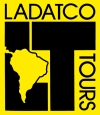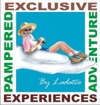

Destinations
Experiences
 |
L A
D A T C O T O U R
S |
 |
||||||||
| HOME | South America | Falkland Islands | Antarctica | Unique Destinations |
Unique Experiences |
Newsstand | ||||
|
Itinerary A - Southern / Central Route
 |
Highlights
|
SUNDAY
Morning:
Fly to Puerto Baquerizo Moreno on SAN CRISTOBAL Island, and transfer by bus then Zodiac to the ORIGIN anchored in the bay. Welcome briefing and safety drill.
Buffet lunch is served on board.Afternoon:
In the afternoon, travel by bus to Cerro Tijeretas (Frigatebird Hill), one of two sites where you can see nesting colonies of both species of frigatebirds (Great and Magnificent), as well lava lizards, the medium ground finch and the San Cristobal mockingbird. Walk along the trail to Punta Carola for scenic views, then return to the ORIGIN.
Evening:
Briefing followed by our Captain’s welcome party and dinner.
MONDAY
Morning:
Go ashore this morning at Punta Pitt, a tuff formation that serves as a nesting site for many sea birds including all three types of boobies – blue-footed, red-footed and Nazca, both frigatebird species, swallow-tailed gulls, storm petrels, shearwaters and brown pelicans. Punta Pitt is considered one of the best sites for birds in the archipelago, and is also home to a colony of sea lions. At Pitt Rock, we snorkel or swim with sea lions and colorful fish such as King Angel and Surgeon fish.
Return to the ORIGIN for lunch.
Afternoon:
Spend the afternoon at Cerro Brujo, a breathtaking white coral beach, with expansive views and good birdwatching. Take a peaceful walk along the beach, swim with sea lions or use the kayaks or stand-up paddle boards. Enjoy a zodiac ride through a cave called The Cathedral before returning to the ORIGIN .
Evening:
Briefing followed by dinner.
TUESDAY
Morning:
Disembark at Punta Suarez on ESPANOLA (Hood) Island, home to the greatest number of endemic species found in Galapagos. Sea lions bark noisy greetings as we land on the beach, while curious mockingbirds peck at our shoelaces. Colonies of blue-footed boobies engage in sky-pointing to show off for potential mates. From April to December, the waved albatross, found only on Espanola, performs its wild mating ritual. Other easily spotted wildlife are the Nazca boobies busily caring for their young, stunning swallow-tailed gulls, the only nocturnal gulls in the world. We also find Darwin’s Finches, Galapagos Doves, red-billed tropicbirds and Galapagos Hawks, as well as a unique species of marine iguanas with traces of red and green colorings. Follow the trail to the dramatic ocean blow hold, watch for colorful sally light-foot crabs crawling along the shoreline.
Return to the ORIGIN for lunch on board.
Afternoon:
Disembark at Gardner Bay, where large colonies or sea lions dot the seemingly endless white-sand beach. Enjoy time to take a leisurely stroll or relax on the beach, watching for birds such as the Galapagos hawk, Darwin’s finch, or Hood mockingbird. Swim with the playful sea lions from the beach, explore the bay and islets by kayak or take a Zodiac ride to explore the caves covered with invertebrates. Admire the colorful array of underwater life at the excellent snorkeling site near Tortuga Rock. Return to the ORIGIN.
Evening:
Briefing followed by dinner..
WEDNESDAY:
Morning:
Step ashore at Punta Cormorant on FLOREANA (Charles) Island, where the olive-sand beach is alive with the sounds of sea lions, lava herons, yellow-crowned night herons, blue-footed boobies, and penguins. Follow a trail to a brackish lagoon, home to Bahama ducks, common stilts, Galapagos flycatchers, yellow warblers and the greater flamingos. Wind your way past a rich variety of plants including the morning glory, cut-leaf daisies, mangroves (black, red and white), palo verde and scalesia. The trail leads to a beach where sea turtles lay their eggs in the powdery sand dunes and sting rays swim in the shallow water. After the walk, there is an opportunity to snorkel at Devil’s Crown, a shallow sunken crater colonized by a brilliant array of colorful fish and coral, white-tipped sharks, sea turtles, spotted eagle rays and sea stars.
Lunch is served back on board the ORIGIN on the sundeck, weather permitting.
Afternoon:
Floreana is one of the ew populated islands in Galapagos with a rich and intriguing human history. After lunch, visit one of the most famous sites in Galapagos, Post Office Bay, where a post barrel was erected in the late 18th Century for use by English whaling vessels. Visitors are invited to leave a post card and to pick up any mail destined for their home area. There is an opportunity to swim from the beach with sea lions. Late afternoon, take a Zodiac ride near Baroness Point to look for sea turtles and rays.
Evening:
Briefing followed by dinner..
THURSDAY
Morning:
Disembark at Puerto Ayora, SANTA CRUZ Island, the social hear of the Galapagos, with a population of 24,000. Travel by bus to the highlands, passing through all seven vegetation zones found in Galapagos. Visit a tortoise reserve, a private farm that protects giant tortoises in their natural habitat. Stop at the largest lava tubes in the archipelago, and visit Los Gemelos, (The Twins), a pair of large craters.
Return to the ORIGIN for lunch on board.
Afternoon:
This afternoon we visit the Centro de Crianza Fausto Llerena (formerly the Charles Darwin Research Station). Visit the tortoise corals and the breeding center with hatchlings and miniature tortoises that will be repatriated when grown. Scientists from all over the globe conduct biological research at the station from anatomy to zoology. Visit the new exhibit honoring Lonesome George, a worldwide icon of conservation as the last surviving tortoise from Pinta Island that tragically died of natural causes. Stroll through town to shop for souvenirs or stop at an internet café.
Return to the ORIGIN for dinner or, if you wish, remain ashore for dinner on your own. Zodiac shuttles from ORIGIN to the main dock will be offered throughout the evening.
FRIDAY
Morning:
Go ashore today at Sombrero Chino (Chinese Hat), a small island off the southern tip of Santiago that owes its name to its shape. After landing on a beach with colonies of sea lions, follow the trail to a primeval landscape of volcanic rubble including cracked lava formations and tubes. Marine iguanas and pairs of oystercatchers are commonly seen. Snorkel at a site frequented by large numbers of Galapagos penguins.
Return to the ORIGIN for lunch on board.
Afternoon:
After lunch, disembark at BARTOLOME, a young Island is inhospitable to most plants and animals. Climb the long wooden staircase to the summit of a dormant volcano, pausing along the way to marvel at lava bombs, spatter cones and cinder cones. It seems as if we are walking on the moon! The panoramic view from the top encompasses the entire island, including the distinctive eroded tuff cone known as Pinnacle Rock. The crystal clear water below beckons for snorkeling with schools of tropical fish, white-tipped reef sharks and Galapagos Penguins. Take a Zodiac ride along the rocky shoreline.Evening:
Briefing followed by dinner..
SATURDAY
Morning:
Today’s visit is at SOUTH PLAZA, a small geological uplift with tall cliffs where swallow-failed gulls, shearwaters, and red-billed tropicbirds build their bests. The trail leads us through Opuntia (prickly pear) and Sesuvium, and land iguanas are seen here feeding on cactus leaves. The island is also home to a colony of bachelor sea lions, with dominant bulls in various stages of recovery from battles over prime beach territory. Return to the ORIGIN and snorkel between North and South Seymour in deeper water.
Return to the ORIGIN for lunch on board.
Afternoon:
After lunch, go ashore at NORTH SEYMOUR, a small geological uplift to observe swallow-tailed gulls, blue-footed boobies and endemic land iguanas. Visit the largest colony of Magnificent frigatebirds in the Galapagos, and watch for marine iguanas and sea lions body surfing the northern swells. Return to the ORIGIN.
Evening:
Captain’s farewell cocktail party and dinner, followed by a slide show presentation.
SUNDAY
Morning:
Travel by bus to the Interpretation Center on San Cristobal to gain a more complete understanding of the natural and human history of the Islands. Afterwards, spend time in port before heading to the airport for your flight back to the mainland.